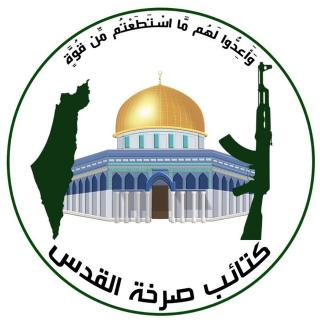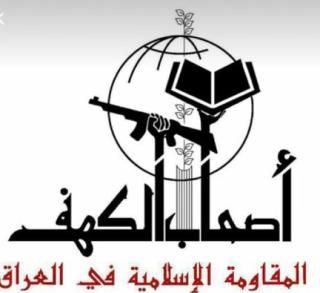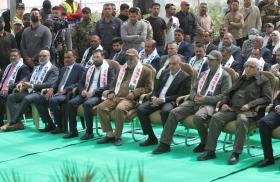
Profile: Kataib Sarkhat al-Quds (formerly known as Ashab al-Kahf)

Part of a series: Militia Spotlight: Profiles
or see Part 1: How to Use Militia Spotlight: Profiles
The first and best-known of the facade groups that Iran-backed militias use to conceal their involvement in operations, Kataib Sarkhat al-Quds (formerly known as Ashab al-Kahf) has a particularly strong connection to AAH and, more recently, HaN.
Name: Kataib Sarkhat al-Quds (KSQ) (Cry of Quds Brigade), formerly known as Ashab al-Kahf (Companions of the Cave). (Name change noted here, August 20, 2024).
Type of movement: Facade group. Kinetic military operations. Initially specialized in Iraq-focused counter-U.S. operations. More recently launching operations in Syria.
History and objectives:
- KSQ, formerly known as Ashab al-Kahf (AK), is the oldest of the current militia facade groups, first appearing in 2019 and remaining continually active ever since. Among Iraqis, it is one of the best-known facade groups, and its name is sometimes used as shorthand for new militia groups. An April 2023 interview with a self-described AK member suggested the group may have been active since 2017 but was constrained from attacking U.S. forces due to ongoing major combat operations against the Islamic State, in which the United States was a partner.
Revised Ashab al-Kahf logo (January 2021 onward) more in keeping with standard muqawama themes.
- In an August 19, 2024, statement, the group changed its name from Ashab al-Kahf to KSQ, "confirming the truth that we affirmed in this battle since its inception in that our goals are not limited to the borders of Sykes-Picot, which were imposed by the colonizers on our Islamic world." This is an indication that KSQ is trying to expand its operations beyond Iraq. The group also introduced a new logo.
Note: For the purposes of clarity in any points related to pre-August 19, 2024, the group will be described as Ashab al-Kahf (AK) in the remainder of this profile.
- AK claims that its first anti-U.S. attack was the October 1, 2017, killing of American soldier Alexander Missildine in Tikrit. AK subsequently claimed the attack in May 2023, saying that it could not take credit at the time because other muqawama (resistance) members did not then approve of such attacks.
- AK claims responsibility for attacks carried out by fasail (armed groups). It has claimed improvised explosive device attacks on convoys since March 2020 and at least two rocket attacks: one on the U.S. embassy (November 17, 2020) and one against Turkish forces (February 15, 2021).
- The group primarily communicates through branded statements published online, which are then quickly reposted across the militia networks.
- AK initially appeared to have less of a kinetic focus than Usbat al-Thaireen or Qasem al-Jabbarin, but claimed increasing numbers of convoy attacks from November 2020 onward. Perhaps this coincided with a rift between Kataib Hezbollah (KH) and Asaib Ahl al-Haq (AAH) over strategy.
- In late 2020, AK seemed to lean toward AAH (and away from KH) during a period when the muqawama were internally feuding. On December 25 of that year, AK joined the fierce media campaign to release an imprisoned AAH operator, issuing statements confirming its readiness to take to the streets if so ordered by the AAH leadership. This supports other indications that in its early days, AK was affiliated with AAH too. At the time, KH and its channels were less supportive of the prisoner. In December 2020 and early January 2021, affiliated media accounts issued thinly veiled criticisms of KH's militia strategy. This rift seemed to close around January 6.
- In May 2021, amid a crisis in Gaza, AK claimed to fire five rockets at Yesud HaMaala, a location under Israeli control close to the Golan Heights.
- AK changed its logo to an image closer in style to other muqawama groups in early 2021. It then took over from Qasem al-Jabbarin as the primary claimant of convoy attacks in October 2021.
- On March 15, 2021, AK threatened then-prime minister Mustafa al-Kadhimi with "humiliation and defeat" for removing militia staff members "according to the taste of the Americans and the English with Saudi and Emirati money."
- On August 1, 2022, AK blamed intra-Shia tensions on "the U.S. embassy and British embassy and other NATO countries" and threatened that "all of their embassies and bases will be targeted."
- In 2023, AK sought to emphasize its status as the last major facade group operating against U.S. forces inside Iraqi territory. In an April 2023 interview, AK pointed to its anti-U.S. "occupation" focus and argued that it was the first group to undertake such attacks since 2017.
- On July 14, 2023, AK organized a protest against the U.S. embassy in Baghdad, the first time it had organized such a protest and a major embarrassment for the Sudani government. AK used the occasion to unveil a new "popular" movement called al-Tabea al-Shabiya fil Iraq (the Popular Mobilization in Iraq, aka the Iraqi Basij). Following this, AK claimed in August that its members were being victimized and arrested by other Iran-backed muqawama members in the government.
Chain of command:
- The preponderance of evidence indicates that AK is an Iran-backed Sadrist splinter group with fraternal ties to Asaib Ahl al-Haq and Harakat Hezbollah al-Nujaba (HaN). In the initial phase of AK's development, social media accounts associated with AAH appeared to be particularly closely related to AK.
- Militia Spotlight assesses that in late 2021, AK became more closely aligned with HaN leader Akram Kaabi. This is based on:
- Kaabi's endorsement of AK (alongside other facade groups) in a December 2021 televised speech. The AK flag was one of several shown behind Kaabi.
- Heavy promotion of AK by HaN-affiliated social media accounts such as the Jihad Brothers Team.
- The content of AK’s statements.
- Claims that AK convoy attacks are nominally under the Iraqi Resistance Coordination Committee (al-Haya al-Tansiqiya lil-Muqawama al-Iraqiya, or Tansiqiya for short). Kaabi is increasingly recognized by muqawama media (including the largest channel, Sabereen News) as the leader of the Tansiqiya.
- During Quds Day commemorations on April 14, 2023, Kaabi was the only top-level militia leader to publicly speak on behalf of the Tansiqiya.
- In November 2023, AK explicitly referenced Kaabi as its leader: "We in the Islamic Resistance Ashab al-Kahf send an unequivocal message that we are ready and will continue to strike American bases until our land is liberated from this brutal enemy...We are at the disposal of the leader...Akram Kaabi."
Affiliate relationships:
- In the initial phase of AK's development, social media channels affiliated with the group announced their closeness to AAH and its secretary-general, Qais al-Khazali. In addition, "Ashab al-Kahf" was one of the first names used by the AAH network before 2010. There is no dissonance in AK having close relations with both AAH and HaN, since these groups emerged from the same Iran-backed splintering of the Sadrist movement in the mid-2000s and were initially the same group (AAH) until Kaabi formed HaN.
- Sabereen News posts some AK claims and statements on the group's behalf.
- During spring and summer 2020, before the muqawama feud later that year, AK and Usbat al-Thaireen appeared to have a close and complementary relationship as the two primary facade groups claiming responsibility for attacks on the coalition while disseminating muqawama propaganda.
Subordinate elements:
- AK operates its own media channels on Telegram and Twitter. Al-Qudsiyoun, a Telegram channel, also appears affiliated with AK.
- AK claimed control of a new "popular" movement called al-Tabea al-Shabiya fil Iraq in July 2023, but it did not reappear since its protests at the U.S. embassy.
- AK may directly control roadside bombing and rocket crews drawn from HaN networks, or it may strictly be a media operation.










